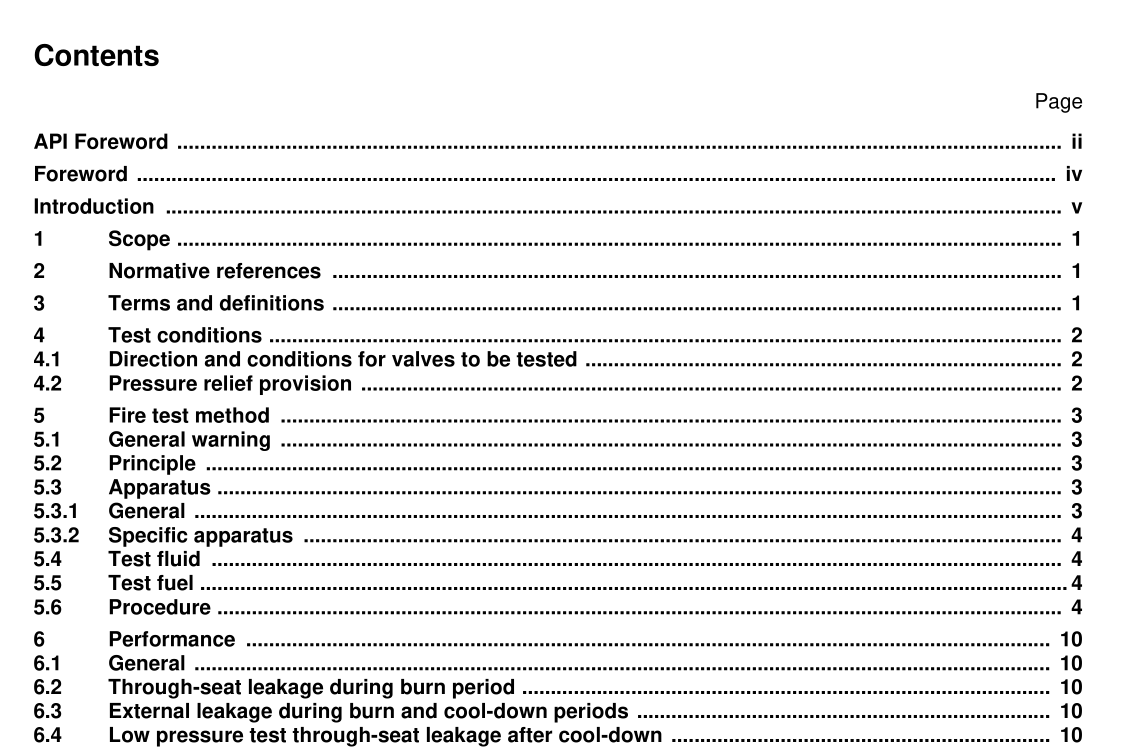ANSI API 607 pdf download

ANSI API 607 pdf download.Testing of valves — Fire type-testing requirements
1 Scope
This International Standard specifies fire type-testing requirements and a fire type-test method for confirming the pressure-containing capability of a valve under pressure during and after the fire test. It does not cover the testing requirements for valve actuators other than manually operated gear boxes or similar mechanisms when these form part of the normal valve assembly. Other types of valve actuators (e.g. electrical, pneumatic or hydraulic) may need special protection to operate in the environment considered in this valve test, and the fire testing of such actuators is outside the scope of this International Standard. NOTE For the purposes of this International Standard, the terms “fire type-test” and “fire test” are synonymous.
3 Terms and definitions
For the purposes of this document, the following terms and definitions apply. 3.1 nominal size DN alphanumeric designation of size for components of a pipework system, which is used for reference purposes, comprising the letters DN followed by a dimensionless whole number which is indirectly related to the physical size, in millimetres, of the bore or outside diameter of the end connections [ISO 6708:1995, definition 2.1] 3.2 nominal pressure PN numerical designation relating to pressure which is a convenient rounded number for reference purposes, and which comprises the letters PN followed by the appropriate reference number NOTE 1 It is intended that all equipment of the same nominal size (DN) designated by the same PN number have compatible mating dimensions. NOTE 2 The maximum allowable working pressure depends on materials, design and working temperatures, and is to be selected from the tables of pressure/temperature ratings given in the appropriate standards. NOTE 3 Adapted from ISO 7268:1983, Clause 2.3.3 NPS alphanumeric designation of size for components of a pipework system, which is used for reference purposes, and which comprises the letters NPS followed by a dimensionless number indirectly related to the physical size of the bore or outside diameter of the end connections NOTE The number following the letters NPS does not represent a measurable value and is not intended to be used for calculation purposes except where specified in the relevant standard. 3.4 Class alphanumeric designation used for reference purposes related to a combination of mechanical and dimensional characteristics of a component of a pipework system, which comprises the word “Class” followed by a dimensionless whole number NOTE The number following the word Class does not represent a measurable value and is not intended to be used for calculation purposes except where specified in the relevant standard. 3.5 symmetric seated valve valve with an internal construction which has a plane of symmetry perpendicular to the axis of the body ends NOTE This is a valve where both seat sealing elements are identical. 3.6 asymmetric seated valve valve with an internal construction which has no plane of symmetry perpendicular to the axis of the body ends NOTE This is a valve with a single seat offset from the shaft centreline.
4 Test conditions
4.1 Direction and conditions for valves to be tested 4.1.1 Symmetric seated valves intended by the manufacturer for bi-directional installation shall be tested in one direction only. 4.1.2 Asymmetric seated valves intended by the manufacturer for bi-directional installation shall be tested by carrying out the burn test procedure twice, once in each direction of the potential installation. The same valve may be refurbished and re-tested, or another, identical, valve may be tested in the other direction. 4.1.3 Valves intended solely for unidirectional installation shall be clearly and permanently marked as such and shall be tested in the stated direction of installation. 4.1.4 If the valve being tested is fitted with a gearbox or other such manual device, then only that particular assembly shall qualify. If a valve can be supplied with or without a gearbox, testing with a gearbox fitted shall qualify valves without a gearbox but not the converse. 4.1.5 Valves (and gearboxes) shall not be protected with insulation material of any form during testing, except where such protection is part of the design of the component(s).









